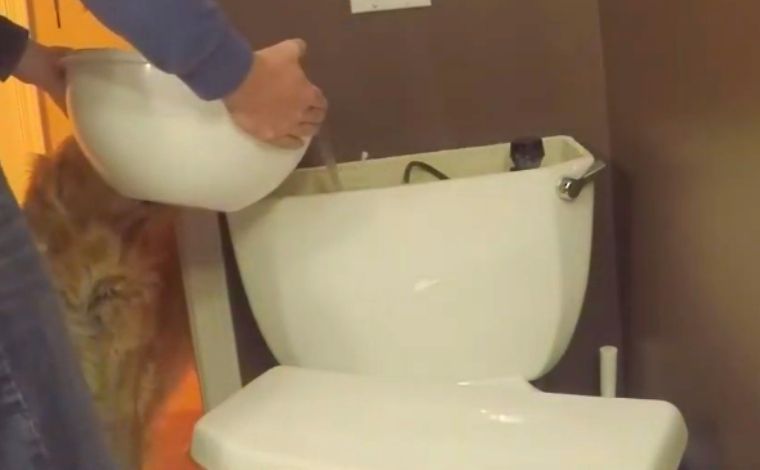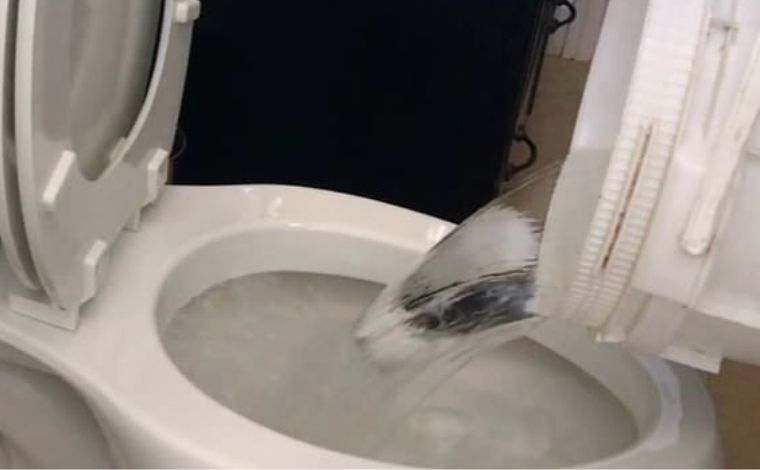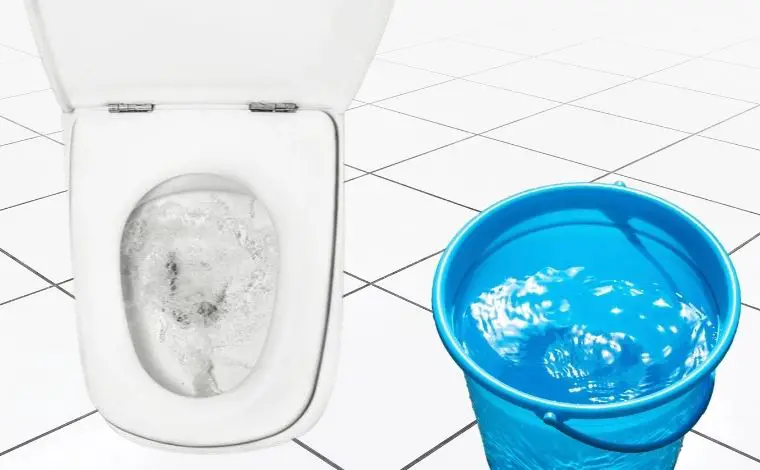It’s easy to take your toilet for granted. You use it daily, and it quietly does its job without complaint. But the moment it stops working — especially when there’s no water — it feels like chaos. Imagine this: you finish using the toilet, press the flush handle, and realize there’s no sound of running water. The tank is empty. The panic sets in immediately.
What now? Should you rush to your neighbor’s house with a bucket? Wait for the water supply to return? Or simply give up for the moment? Don’t worry — this situation is more common than you might think. The good news is that there are practical, simple ways to flush a toilet even when there’s no running water.
This complete guide will help you understand why your toilet won’t flush without water, and show you step-by-step methods to get it working again — safely, effectively, and hygienically.
Understanding Why Toilets Need Water to Flush
A toilet’s flushing system depends entirely on water pressure and gravity. When you push the flush handle, a valve opens and releases water from the tank into the bowl. That rush of water creates a suction effect that pushes waste through the trap and into your home’s drainage pipes.
When the water stops, this process collapses. The tank doesn’t refill, the bowl doesn’t clear, and you’re left with an unflushed mess. More importantly, without regular flushing, sewer gases might escape into your bathroom, causing unpleasant smells.
Here are the most common reasons your toilet may stop flushing due to a water outage:
-
Municipal maintenance: Temporary shutoffs for pipe repair or cleaning.
-
Home plumbing issues: A closed or broken shutoff valve inside your home.
-
Well or pump failure: If you use a private water system, a power cut or low well level can halt water flow.
-
Frozen pipes: In colder climates, pipes can freeze and block water completely.
-
Emergency restrictions: Droughts or contamination events sometimes cause planned supply interruptions.
Knowing the reason helps you understand how long you’ll be without water — which determines which flushing method to use.
The Hidden Lifesaver: One Last Flush
Even when your water is turned off, your toilet usually holds one last flush in reserve. Most modern toilets store 1.5 to 3 gallons of water in the tank. Unless you’ve already used it, that water is still there — ready to go.
To use it:
-
Lift the tank lid carefully.
-
Check that there’s still water inside.
-
Press the handle as usual.
-
The toilet will flush one final time.
That single flush can be invaluable in emergencies. However, once you use it, the tank won’t refill until the water supply returns, so save it for when you truly need it.
If you suspect an upcoming shutoff (for example, your utility company warns you in advance), avoid flushing unnecessarily. Use the toilet sparingly, and reserve that one flush for solid waste.
After using your last flush, pour a bit of disinfectant, vinegar, or baking soda into the bowl to neutralize odors while waiting for the water to return.
Method 1: The Manual Bucket Flush
When the tank is empty and there’s no water supply to refill it, you can manually trigger a flush using the simplest tool in your house — a bucket. It’s the oldest and most reliable solution for emergencies.

Here’s how to do it correctly:
-
Fill a large bucket (around 2 gallons) with water.
-
Stand over the toilet bowl (not the tank).
-
Start pouring slowly, then quickly pour the remaining water in one strong motion.
-
The water’s momentum creates pressure, pushing the waste through the drain just like a normal flush.
For best results, pour the water from about waist height. That gives it enough gravitational force to create a powerful flush.
If the bowl doesn’t clear completely, repeat the process once more with another half-bucket of water. Don’t pour too aggressively from a height that causes splashing — steady pressure is key.
This is often called a gravity flush, and it works surprisingly well. Even in places with limited water access, this method is commonly used as a regular practice.
Method 2: Refilling the Toilet Tank by Hand
If you’d rather keep your toilet working normally — using the handle — you can manually refill the tank. This method restores your toilet’s original flushing mechanism temporarily.

Here’s how:
-
Remove the tank lid gently and set it aside.
-
Use a jug or smaller container to pour clean water into the tank until it reaches about an inch below the overflow pipe.
-
Replace the lid.
-
Press the handle — the toilet will flush normally.
You can repeat this as many times as needed, as long as you have a water source available. This method is cleaner than pouring directly into the bowl and prevents splashing.
If you’re using greywater (recycled household water), such as from dishwashing or bathing, make sure it doesn’t contain bleach or heavy detergents that can harm the rubber parts inside your tank.
This technique is perfect for short outages — you get a full flush without needing the plumbing system to refill the tank.
Method 3: Using Alternative Water Sources
When running water is unavailable, you can still find usable water around your home. You’d be surprised at how resourceful you can become with a little creativity.

Some great sources include:
-
Stored water: If you’ve kept emergency containers or bottles, use those for flushing first.
-
Bathtub water: Filling your tub before a scheduled shutoff can give you 15–20 flushes.
-
Rainwater: Place buckets outside during rainfall. It’s perfectly safe for flushing.
-
Greywater: Collect water from rinsing clothes, washing vegetables, or finishing a shower.
-
Melted ice or leftover bottled water: A quick solution when other sources run dry.
Among all of these, rainwater and bathtub water are the most efficient. Just remember — use clean buckets, and always pour steadily to prevent mess.
If you live in an area with frequent outages, consider installing a rainwater collection system. It can save you hundreds of gallons a month for non-drinking uses like toilet flushing, cleaning, and gardening.
Method 4: The Siphon Jet Trick
Some toilets feature a small jet opening at the bottom of the bowl — the siphon jet. When water flows into it at high speed, it enhances suction, helping to flush more efficiently.
If you’re short on water, aim your bucket pour directly into this small hole while flushing manually. The focused flow helps clear the bowl even with less water. It’s a smart technique when you’re trying to conserve every drop.
When You Should Call a Plumber
All the above solutions are great for temporary emergencies, but if your toilet refuses to flush properly even after the water returns, there might be a deeper problem.
Some warning signs that you need a plumber include:
-
The tank doesn’t refill automatically after water restoration.
-
You hear gurgling or bubbling sounds from the drain.
-
Water leaks from the base of the toilet.
-
The flush handle feels loose or unresponsive.
-
The water pressure throughout the house is unusually low.
These problems could indicate a faulty fill valve, broken flapper, vent blockage, or even a clogged drain line. Getting professional help early can prevent serious plumbing damage later.
While calling a plumber might seem costly, ignoring these problems often leads to expensive repairs. It’s better to act early and restore full functionality safely.
How Much Water Does It Take to Flush a Toilet?
Every toilet design uses a different amount of water. Older models, especially those from before the 1990s, can use 3.5 to 5 gallons per flush. Newer toilets are more efficient — standard ones use about 1.6 gallons, and high-efficiency or dual-flush models use between 0.8 and 1.28 gallons.
For manual flushing during a water outage, you’ll need about 1.5 to 2 gallons of water to achieve a proper flush.
If you’re trying to conserve water, flush only for solid waste. The well-known saying — “If it’s yellow, let it mellow; if it’s brown, flush it down” — is practical advice during emergencies.
This conservation method can cut your household water usage drastically during shortages and help maintain a healthy septic balance.
Eco-Friendly Flushing Ideas
Water scarcity is becoming a real global concern. Learning to manage water during an outage helps you appreciate its value. But beyond that, you can also make your toilet more sustainable year-round.
Here are a few eco-friendly ideas:
-
Upgrade to a dual-flush or high-efficiency toilet.
-
Install a rainwater harvesting barrel for flushing.
-
Use greywater recycling systems for household waste water.
-
Check for leaks regularly; even a slow leak can waste gallons per day.
-
Educate everyone in the house about water-saving habits.
Simple changes like these not only help during outages but also lower your monthly water bills and reduce your environmental impact.
Maintaining Hygiene When There’s No Water
A toilet that won’t flush is more than just an inconvenience — it’s a hygiene risk. During an outage, cleanliness becomes essential.
Here’s how to maintain hygiene effectively:
-
Use hand sanitizer or wet wipes after every use.
-
Sprinkle baking soda or vinegar in the bowl to neutralize odors.
-
Keep the toilet lid closed after flushing manually.
-
Disinfect surfaces using stored water mixed with bleach.
-
Dispose of wipes and paper in a covered trash bin, not in the bowl.
If multiple people share the same toilet during a water cut, establish a simple rule — one flush per few uses for liquids, immediate flush for solids. This balance keeps your toilet clean while conserving water.
Preparing for the Next Outage
Being ready before a problem strikes is always smarter. A little preparation ensures that a future water cut won’t disrupt your daily routine.
Here are some practical habits to adopt:
-
Keep several gallons of emergency water stored in containers.
-
Check your toilet’s shutoff valve regularly to ensure it’s not stuck.
-
Keep one dedicated flushing bucket in the bathroom.
-
Fill your bathtub before scheduled water maintenance.
-
Store disinfectant and gloves for cleaning during outages.
Teaching these steps to everyone in your home ensures calm, not chaos, the next time the taps go dry.
What Happens If You Flush Without Water?
If you flush when there’s no running water, your toilet releases whatever’s in the tank but cannot refill afterward. The bowl may only partially clear, leaving behind residue and odor. It might also let air into the drain system, which can cause gurgling sounds and unpleasant smells.
In short, you waste your one remaining flush and make the situation worse. Always check the tank before pressing the handle during an outage. If it’s already empty, go straight to the bucket or refill methods described earlier.
Appreciating the Value of Water
A few hours without water quickly reminds you how vital it is. Every flush we take for granted represents gallons of clean water moving effortlessly through our homes. Learning to flush manually is more than a survival trick — it’s a small act of awareness.
By adopting smart habits, switching to efficient toilets, and reusing non-drinking water whenever possible, you not only prepare for emergencies but also become part of a long-term solution for water conservation. Every drop counts.
Final Thoughts
When the water stops flowing, a toilet that won’t flush can cause panic. But now you know that there are easy, reliable solutions. You can use that one last flush in the tank, perform a bucket flush, refill the tank manually, or find alternative sources of water like rain or bathtub reserves. With these methods, you can stay calm, clean, and comfortable even during a temporary water outage.
If your toilet still doesn’t work after the water comes back, don’t hesitate to call a plumber to inspect it.
In the end, being prepared is always better than being surprised. So keep a few gallons of water stored, know how your toilet functions, and be ready for anything. Water is precious — use it wisely, and your toilet will keep running smoothly no matter what.
Hi, this is Robert Crossan, the owner of this website, has 17 years of experience in the installation, maintenance, and repair of toilets and plumbing systems. After completing the Level 2 Basic Plumbing course in 2005, I started working in both domestic and commercial buildings as a professional plumber. So I can figure out the core difference between different toilet models and brands. It also helped me monitor their work performance and setbacks.